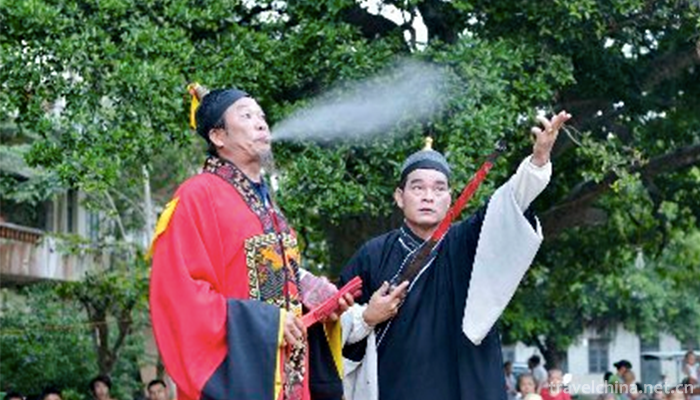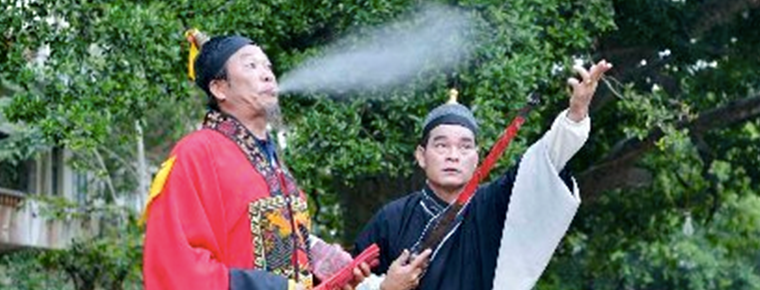Hainan Zhai Opera
Hainan Zhai Opera
Hainan Zhai Opera is a traditional sacrificial ritual drama in Hainan Province. It is similar to the Nuo Opera in northern China. It is known as "Nuo Opera in the north and Zhai Opera in the south". It originates from the folk sacrificial ceremony. Early sacrificial ceremonies were simple dances and chanting incantations, which were called "making a fast" in Hainan folk. With the introduction of foreign operas, sacrificial rituals absorbed the nutrition of the opera "singing and dancing stories" and developed into Zhai opera. Zhai Opera is the primary form of Hainan Opera. Qiongju Opera, the largest local opera in Hainan, was born out of Zhai Opera. Zhai Opera was produced in Ming Dynasty at the latest and has a history of more than 400 years.
On May 23, 2011, Hainan Zhai Opera declared by Haikou City of Hainan Province was listed in the third batch of national intangible cultural heritage list with the approval of the State Council.
historical origin
Hainan people also say "watch Zhai" when they watch Qiongju Opera. The so-called "Zhai" is Zhai Opera in Hainan.
Hainan Zhai Opera is a sacrificial ritual opera, similar to the Nuo Opera in the north of China, known as "Nuo Opera in the north and Zhai Opera in the south", which originates from the folk sacrificial ceremony.
Early sacrificial ceremonies were simple dances and chanting incantations, which were called "making a fast" in Hainan folk. With the introduction of foreign operas, sacrificial rituals absorbed the nutrition of the opera "singing and dancing stories" and developed into Zhai opera.
Zhai Opera is the primary form of Hainan Opera. Qiongju Opera, the largest local opera in Hainan, was born out of Zhai Opera. Zhai Opera was produced in Ming Dynasty at the latest and has a history of more than 400 years.
Inheritance significance
Hainan Zhai Opera has classes, artists, plays, music and performance programs. It has its own system and unique style. Zhai Opera retains the legacy of Chinese opera since Song and Yuan Dynasties, which is of great value to the study of the history of Chinese opera.
Zhai Opera is the product of folk activities, which is highly ornamental, or the spiritual link connecting Qiongzhou overseas Chinese. It integrates Hainan folk stories, ballads, folk operas, music, acrobatics, crafts and other artistic elements, and becomes the carrier of preserving Hainan traditional culture and art.
Inheritance and protection
Due to the impact of fashion culture, Zhai Opera is on the verge of losing its heritage and needs urgent protection. June 2011 was selected as the third batch of national intangible cultural heritage list.


-
1.sausageTime 2018-10-12
-
2.Mount Emei
Mount Emei is located in Mount Emei, Leshan City, Sichuan Province, China.
Time 2018-10-13 -
3.Park hyatt Guangzhou
In Guangzhou Park Hyatt Hotel, a traditional Lingnan culture and Gourmet Tour is opened. Guangzhou Baiyue Hotel integrates Lingnan's long history and culture with Baiyue's delicate modern
Time 2018-12-16 -
4.Qiankun Bay Scenic Area
Qian Kun Wan Scenic Area is located in Qian Kun Wan Town, Yanchuan County, Yan'an City, Shaanxi Province. It faces the Yellow River to the East and Yonghe County, Shanxi Province
Time 2018-12-22 -
5.Chaibuxi Canyon Scenic Area
Chaibuxi Canyon Scenic Area is located in the eastern part of Wufeng Tujia Autonomous County, with Wulingyuan in the South and Qingjiang River in the north. Zhangjiajie belongs to Wuling Mountains.
Time 2019-01-04 -
6.Expo Area of Acient Kiln Folk Cultures in Jingde
Jingdezhen Ancient Kiln Folklore Expo Area, located in Fengshu Mountain and Panlonggang, Changjiang District, Jingdezhen City, Jiangxi Province, covers an area of 83 hectares. It is a cultural tourist
Time 2019-01-12 -
7.Ma Xian Xing custom
The belief in Ma Xian is a traditional folk custom inherited from generation to generation by the people of Fujian and Zhejiang. Ma Xian, also known as Ma Xiaoxian, is a goddess worshipped in northeas
Time 2019-05-16 -
8.monologue storytelling accompanied by drumbeats
Plum blossom drum, born in the middle of the Qing Dynasty, originated in Beijing, is popular in Beijing and Tianjin. Before liberation, the sons and daughters of Beijing Banner People liked to sing me
Time 2019-06-03 -
9.Qing Opera of Wa Nationality
The Wa Qing Opera belongs to the high-pitched system, with different roles for men and women. The roles are similar to those of Sheng, Dan, Jing and Wei. Use a dye called "Red Drug" to colou
Time 2019-06-25 -
10.Erwang Temple
The Erwangmiao ancient building complex is located at the foot of Yulei mountain outside the west gate of today's Dujiangyan, which is an important part of the world cultural heritage Dujiangyan. The temple was built in memory of Li Bing and his son Erlang. The Erwang temple was first built in the northern and Southern Dynasties
Time 2020-11-08 -
11.Public education in Chengdu Giant Panda Base
From 2003 to 2016, Chengdu base received more than 100000 primary and secondary school students at home and abroad, and trained more than 800 volunteers; went to colleges and universities, communities, primary and secondary schools, kindergartens and nature
Time 2020-12-13 -
12.Transportation in Mianyang
By the end of 2018, Mianyang had 20146 km of highways, 412 km of expressways, 268 km of Railways and 57 civil aviation routes.
Time 2020-12-14